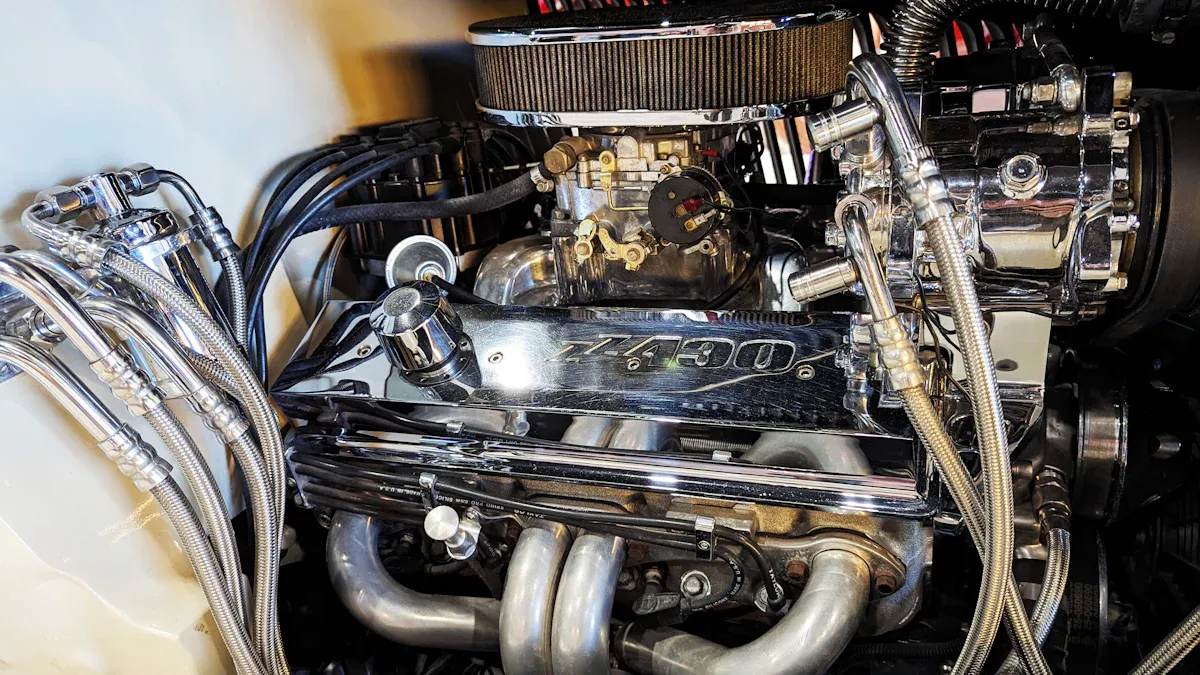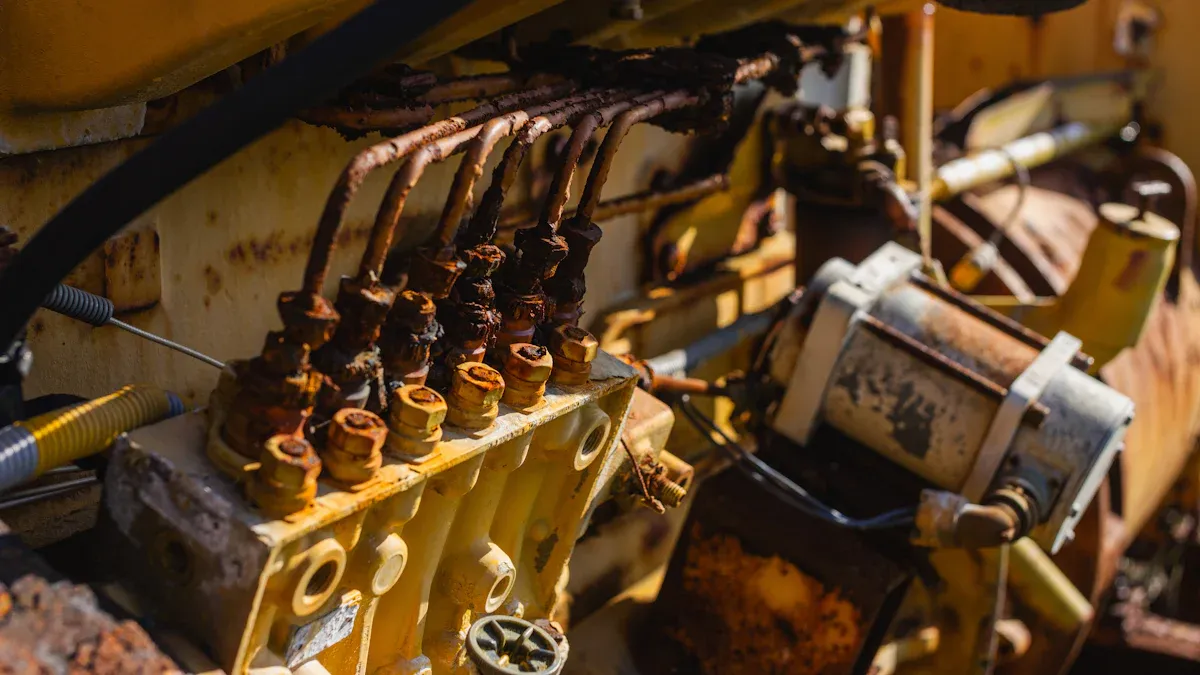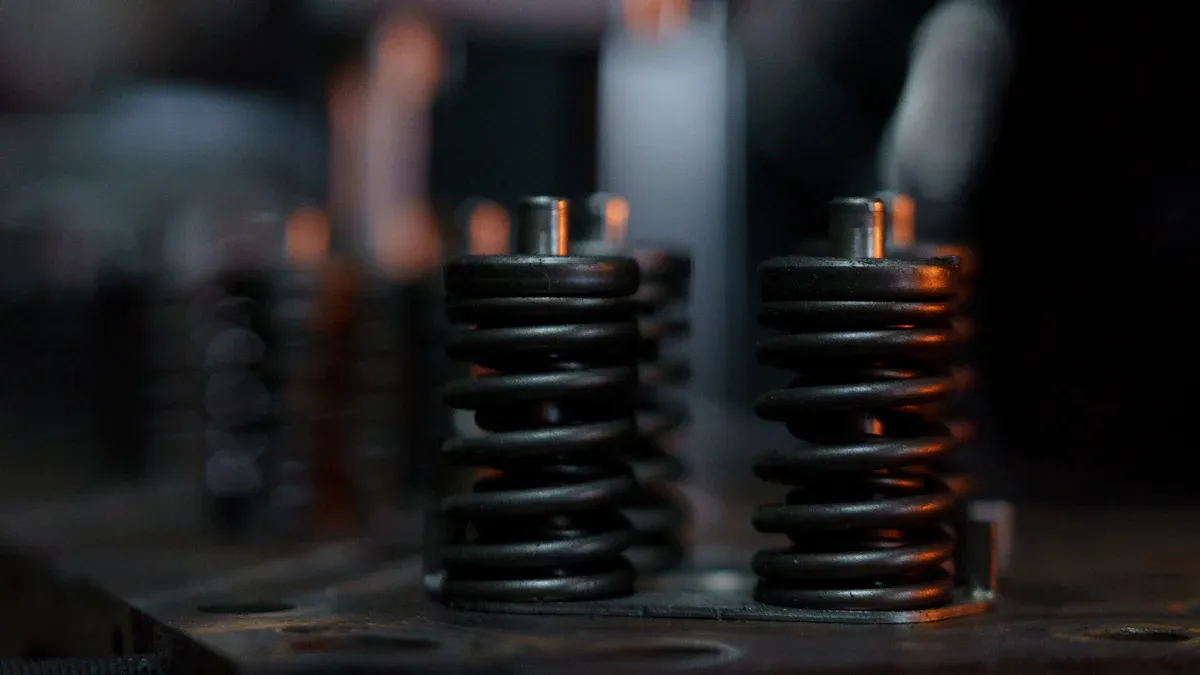

fortuneau
July 19, 2025
What Are the Differences Between Intake and Exhaust Car Valves

You rely on car valve technology every time you start your engine. Intake valves allow the air-fuel mixture to enter, while exhaust valves let burnt gases exit the combustion chamber. Modern engines use advanced valve materials like steel and bimetallic alloys to handle intense heat and pressure. The intake process impacts engine power and efficiency, as the air-fuel mixture must flow smoothly. Exhaust valves face higher temperatures, which helps burn off deposits, keeping them cleaner than intake valves. Understanding how valves work helps you maintain engine performance and extend its lifespan.
Did you know? The global exhaust valve market for passenger vehicles reached $1.5 billion in 2024, with intake valve technology growing rapidly at a 14% CAGR due to its role in clean, efficient combustion.
Engine Valves: Intake Valves vs. Exhaust Valves

Intake Valves in the Engine
You find intake valves at the heart of every car engine. These valves play a key role in internal combustion engines by letting the air-fuel mixture enter the combustion chamber. When the piston moves down during the intake stroke, the intake valve opens. This action creates a vacuum that draws the mixture into the cylinder. The camshaft controls the timing, making sure the valve opens and closes at the right moment. This precise movement helps the engine get the correct amount of air-fuel mixture for each cycle.
The function of the intake valve directly affects engine power and efficiency. If the valve opens at the wrong time or does not seal tightly, the engine loses performance. Intake valves work under cooler conditions compared to exhaust valves because the air-fuel mixture helps cool them. Most car engine valves use strong materials like steel with chrome and silicon alloys for durability. You can see how important intake valves are when you look at the types of valves in an engine. Each one must work perfectly to keep the engine running smoothly.
Tip: Intake valves act as gatekeepers, allowing just the right amount of air-fuel mixture into the engine. Good timing and sealing mean better combustion and smoother driving.
Exhaust Valves in the Engine
Exhaust valves handle a different but equally important job in your car engine. After the air-fuel mixture burns, the exhaust valve opens as the piston moves up during the exhaust stroke. This lets hot combustion gases leave the cylinder. The exhaust valve then closes to seal the chamber for the next cycle. Exhaust valves face much higher temperatures than intake valves, sometimes reaching up to 800ºC. They must withstand high pressure and heat, so manufacturers use tough materials like steel with chrome and magnesium alloys. Some exhaust valves even have hollow heads filled with sodium to help with heat dissipation.
Exhaust valves also rotate slightly with each cycle. This rotation helps spread out wear and keeps the valve seat clean. If exhaust valves do not open or close at the right time, backpressure can build up, hurting engine performance. The main function of exhaust valves is to remove burnt gases quickly and efficiently. This keeps the engine cool and ready for the next intake stroke. When you look at car engine valves and their functions, you see that exhaust valves are vital for keeping the engine clean and efficient.
| Aspect | Intake Valve | Exhaust Valve |
|---|---|---|
| Function | Allows air-fuel mixture into combustion chamber | Expels combustion gases from chamber |
| Operating Temp. | 200ºC to 300ºC | Up to 800ºC |
| Material | Steel with chrome/silicon alloys | Steel with chrome/magnesium, sodium-filled heads |
| Cooling | Cooled by air-fuel mixture | Heat released through valve seat |
Car Valve Functions in the Engine Cycle
Intake Valves During Combustion
You see how intake valves play a vital role in internal combustion engines. During the intake stroke, the intake valve opens. This action lets the air-fuel mixture enter the cylinder. As the piston moves down, the mixture fills the combustion chamber. When the piston starts moving up for the compression stroke, the intake valve closes. This closure keeps the mixture sealed inside. During the power stroke, the intake valve stays closed. This step is important because it keeps the combustion gases inside the cylinder. The explosion pushes the piston down, creating power for the engine. Intake valves must open and close at the right time for the engine to work well. If the intake valve does not seal properly, you lose power and efficiency.
Note: Intake valves do not open during the combustion phase. They stay closed to contain the gases and help generate maximum power.
Exhaust Valves During Combustion
Exhaust valves handle the removal of burnt gases from the cylinder. After the power stroke, the piston moves up again. At this point, the exhaust valve opens. This opening allows the hot gases to exit the cylinder. The intake valve remains closed during this phase. The exhaust valve closes when the piston reaches the top, preparing the cylinder for the next intake stroke. In internal combustion engines, exhaust valves must withstand high temperatures and pressure. Their timing is critical. If exhaust valves open too early or too late, engine performance drops. You need exhaust valves to clear out gases quickly so the engine can take in a fresh air-fuel mixture.
Timing and Operation of Engine Valves
Valve timing controls when intake and exhaust valves open and close. This timing affects how engine valves work and how well your engine runs. You can see the four-stroke cycle in the table below:
| Stroke | Valve Action | Role of Valves in Cycle |
|---|---|---|
| Intake Stroke | Intake valve opens; exhaust valve closed | Intake valve opens to let air-fuel mixture in as piston moves down. |
| Compression Stroke | Both intake and exhaust valves closed | Both valves stay closed to compress the mixture. |
| Power Stroke | Both intake and exhaust valves closed | Valves remain closed, allowing combustion to push piston down. |
| Exhaust Stroke | Exhaust valve opens; intake valve closed | Exhaust valve opens to let burnt gases out as piston moves up. |
Modern car engine valves use advanced valve timing. Early intake valve opening helps fill the cylinder at high RPMs. Late intake valve closing uses air momentum to boost power. Early exhaust valve opening releases pressure, making the engine more efficient. Late exhaust valve closing creates valve overlap, which helps clear out gases at high speeds. Camshaft adjustments change valve timing to match engine needs. Good valve timing means better power, smoother idle, and lower emissions. You rely on precise valve timing for strong engine operation and long-lasting car engine valves.
Design and Material Differences in Engine Valves

Shape and Size of Intake and Exhaust Valves
You can spot clear differences between intake and exhaust valves when you look at their shape and size. Intake valves usually have a larger diameter than exhaust valves. This larger size helps more air-fuel mixture enter the engine cylinder, which boosts power and efficiency. For example, in a small block Chevrolet engine, the intake valve might measure about 2.020 inches in diameter, while the exhaust valve is closer to 1.600 inches. The head of the intake valve often looks bowl-shaped to help air flow smoothly into the combustion chamber.
Exhaust valves, on the other hand, are smaller. Their size usually ranges from 75% to 80% of the intake valve diameter. This smaller size helps them handle the higher temperatures and pressures found on the exhaust side. The exhaust gases leave the cylinder at high speed and pressure, so a smaller valve can still do the job well. In high-performance engines, you might see the intake and exhaust valves closer in size, but the intake valve almost always stays larger to maximize airflow.
Here is a table that shows the main differences:
| Aspect | Intake Valves | Exhaust Valves |
|---|---|---|
| Typical Size | Larger diameter (e.g., 2.020 inches) | Smaller diameter (e.g., 1.600 inches) |
| Shape | Bowl-shaped head | Similar shape, but smaller |
| Stem Diameter | Larger, solid or undercut | Smaller, sometimes hollow and sodium-filled |
| Design Focus | Maximize air-fuel flow | Withstand heat and exhaust gas flow |
| Performance Impact | Larger valves improve flow | Smaller valves manage heat better |
Tip: Intake valves need to be bigger because pulling air into the engine is harder than pushing exhaust gases out.
Material Selection for Car Valves
You need strong materials for engine valves because they face tough conditions. Intake valves work in cooler areas of the engine, so they use materials like EV8 stainless steel, IN751 inconel, chrome, nickel, and tungsten steel. These metals give the intake valve enough strength and moderate heat resistance. The air-fuel mixture cools the intake valve, so it does not need to handle extreme heat.
Exhaust valves face much higher temperatures, sometimes over 2,000°F. They need special materials to survive. You often find exhaust valves made from iron, nickel, silicon-chromite, copper-chromium mixtures, and advanced alloys like Nickelvac N80 or Nickelvac 800. Many exhaust valves also have coatings such as chromium plating, phosphating, or nitriding. These coatings help the valve resist wear, corrosion, and heat. Some high-performance exhaust valves use hollow stems filled with sodium. The sodium moves heat away from the valve head, helping it last longer.
Here is a table showing common materials and why they are chosen:
| Valve Type | Common Materials | Reason for Material Choice |
|---|---|---|
| Intake Valve | Chrome, Nickel, Tungsten Steel | Lower temperatures, moderate strength needed |
| Exhaust Valve | Iron, Nickel, Silicon-Chromite, Copper-Chromium, Nickelvac alloys, Special coatings | High heat resistance, wear protection, corrosion resistance |
Note: The right material choice helps engine valves resist heat and wear, making your engine last longer.
Construction and Durability in Engine Valves
You want your engine valves to last as long as possible. Manufacturers use special construction techniques to boost durability. For intake valves, you often see solid or undercut stems. These designs help reduce weight and improve airflow. Exhaust valves need even more advanced construction. Many use hollow stems, sometimes filled with sodium, to move heat away from the valve head. This keeps the exhaust valve cooler and less likely to fail.
Engine valves also get special coatings. Stellite, a cobalt-based alloy, is often used on valve faces and stems. This coating protects against heat, friction, and wear. Some valves use dry film lubricants or ceramic thermal barriers to reduce friction and stop carbon from building up. Titanium valves are popular in high-performance engines. They are about 40% lighter than steel valves, which helps the engine run at higher speeds and reduces stress on the valve train.
Manufacturers use CNC machining to make sure each valve meets exact specifications. This precision helps the valve seal tightly and last longer. Some engine valves use beryllium copper seats, which transfer heat away from the valve quickly. This helps prevent overheating and extends the life of both the valve and the seat.
Here are some common construction techniques and their benefits:
| Construction Technique | Description | Purpose/Benefit |
|---|---|---|
| Hollow stem valves (sodium-filled) | Hollow stems with sodium inside | Improved heat transfer, longer valve life |
| Titanium valves and retainers | Lightweight, strong materials | Reduced weight, higher RPM capability |
| Specialized coatings (Stellite, TiN) | Protective layers on valve faces and stems | Increased wear and heat resistance |
| CNC machining | Computer-controlled precision manufacturing | Tight tolerances, better sealing |
| Beryllium copper valve seats | High thermal conductivity alloy seats | Better heat dissipation, improved durability |
Callout: Exhaust valves face the harshest conditions in your engine. They need the best materials and construction to survive high heat and pressure.
You can see that the design, material, and construction of engine valves play a huge role in how well your engine runs and how long it lasts. Intake valves focus on airflow and moderate strength, while exhaust valves must handle extreme heat and stress. The right choices in these areas help your car valve system deliver reliable performance year after year.
Impact of Intake and Exhaust Valves on Engine Performance and Maintenance
Engine Power and Efficiency
You play a key role in your car’s engine performance by keeping the valves in good condition. The intake and exhaust valves control how air and fuel enter and exit the cylinders. When these valves open and close at the right time, the engine breathes better. This improves both power and efficiency. Valve design, including size and shape, affects how smoothly air flows. Advanced features like variable valve timing and lift help the engine adjust to different speeds and loads. These technologies boost efficiency and reduce emissions. Studies show that even a small improvement in valve flow can lower fuel use. For example, a 1% increase in valve flow can cut fuel consumption by 0.5%. When you have precise valve timing, you get more power and better engine efficiency. High performance engines often use special valve designs to maximize airflow and combustion.
Tip: If you notice a drop in power or fuel economy, check the valves. Small issues can have a big impact on engine performance.
Reliability and Lifespan of Engine Valves
You depend on the reliability of your engine valves for long-lasting performance. Many factors affect how long valves last. High temperatures, pressure, and constant movement cause wear over time. Valve springs help keep the valves sealed, but they can weaken with use. If the springs wear out, you may notice symptoms of bad engine valves, such as loss of power or strange noises. Deposits on the valve seat or stem can also cause leaks and burning. In high performance engines, valves face even more stress, so strong materials and good cooling are important. Regular inspection helps catch problems early. If you see signs like blue smoke or hard starting, the valves may need attention.
- Common causes of valve failure:
- Worn valve guides or seats
- Sticky valves from deposits
- Overheating due to cooling issues
- Weak or broken valve springs
Maintenance Tips for Intake and Exhaust Valves
You can extend the life of your engine valves with simple maintenance steps. Change the oil and filters on schedule to keep the engine clean. Replace timing belts or chains before they wear out to avoid valve damage. Inspect valve clearance every 60,000 miles to ensure proper adjustment. Clean air filters help prevent dirt from damaging the valves. Watch for warning signs like rough idling, smoke, or tapping noises. Address these issues quickly to protect engine performance and efficiency.
Here are some maintenance tips:
- Follow the manufacturer’s maintenance schedule.
- Change oil, air, and fuel filters regularly.
- Keep the cooling system in good shape.
- Replace timing belts or chains as recommended.
- Inspect valves and springs during major services.
- Avoid harsh driving habits that stress the engine.
- Respond to unusual noises or smoke right away.
Note: High performance engines need even more careful valve maintenance due to higher stress and heat.
You see that intake and exhaust valves each have a unique job in your engine. Intake valves let the air-fuel mixture in, which affects power and efficiency. Exhaust valves remove hot gases, preventing backpressure and keeping the engine running smoothly. These valves use different materials because exhaust valves face higher heat. Proper valve timing and regular maintenance help you avoid misfires, power loss, and increased emissions. When you check valve clearance and replace worn parts, you protect engine performance and extend engine life.
- Intake valves control the mixture entering the engine, boosting efficiency.
- Exhaust valves expel gases, preventing damage and supporting performance.
- Regular valve maintenance keeps your engine reliable and efficient.
FAQ
What happens if an intake or exhaust valve fails?
If a valve fails, your engine may lose power or run rough. You might hear tapping noises or see smoke from the exhaust. Bad valves can cause poor fuel economy. You should fix valve problems quickly to avoid engine damage.
How often should you check your car’s valves?
You should check your car’s valves every 60,000 miles or as your owner’s manual suggests. Regular checks help you catch problems early. Clean oil and good maintenance keep valves working well.
Can you use the same material for both intake and exhaust valves?
No, you cannot use the same material for both. Intake valves use metals that handle cooler temperatures, like stainless steel. Exhaust valves need stronger, heat-resistant alloys because they face much higher temperatures.
What are signs of worn or damaged valves?
You may notice rough idling, loss of power, blue smoke, or tapping sounds. Sometimes, your car may be hard to start. These signs mean you should have your valves checked soon.
Tip: Early detection of valve issues helps you avoid costly repairs and keeps your engine running smoothly.





